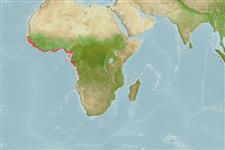Classification / Names
Common names from other countries
Main reference
Size / Weight / Age
Max length : 140 cm TL male/unsexed; (Ref. 5377); common length : 50.0 cm TL male/unsexed; (Ref. 26999)
Environment
Marine; demersal; depth range 80 - 300 m (Ref. 3589)
Climate / Range
Tropical, preferred 27°C (Ref. 107945); 17°N - 13°S, 19°W - 15°E (Ref. 5222)
Distribution
Short description
Dorsal
spines
(total): 11;
Dorsal
soft rays
(total): 16;
Anal
spines: 3;
Anal
soft rays: 8. Distinguished by the following characteristics: brownish head and body; 3-4 broad oblique bars on the dorsal part of the body and another on the dorsal half of the peduncle; 2 narrow faint dark bands extending posteriorly from the lower half of the eye; presence of dark moustache streak, not extending past the rear end on maxilla; body depth less than head length, depth contained 2.9-3.2 times in SL; head length 2.5-2.7 times in standard length; flat or slightly convex interorbital area; angular preopercle, 3-4 enlarged serrae at the angle, lowermost directed ventrally; serrate interopercle and subopercle; well developed middle and lower opercular spines, upper spine not apparent; approximately straight upper edge of operculum; maxilla reaches vertical at rear edge of eye; maxilla naked or with few minute scales dorsally; 2 rows of teeth on midlateral part of lower jaw; posterior nostril about twice the size of anterior nostril (Ref. 89707).
IUCN Red List Status (Ref. 115185)
Threat to humans
Harmless
Human uses
Fisheries: subsistence fisheries
More information
ReferencesAquacultureAquaculture profileStrainsGeneticsAllele frequenciesHeritabilityDiseasesProcessingMass conversion
Tools
Special reports
Download XML
Internet sources
Estimates of some properties based on models
Phylogenetic diversity index
PD50 = 0.5000 many relatives (e.g. carps) 0.5 - 2.0 few relatives (e.g. lungfishes)
Trophic Level
3.9 ±0.64 se; Based on food items.
Resilience
Medium, minimum population doubling time 1.4 - 4.4 years (Assuming tm=3-4)
Vulnerability
Very high vulnerability (78 of 100)
Price category
